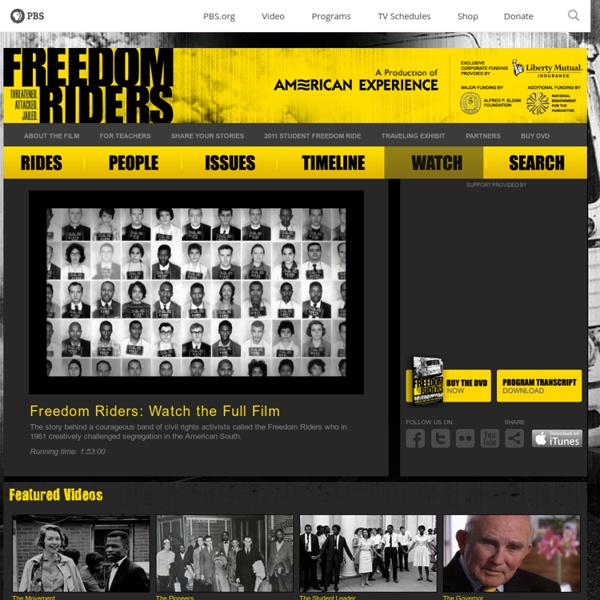



Voting Rights Act - Black History Lyndon Johnson assumed the presidency in November 1963 upon the assassination of President John F. Kennedy. In the presidential race of 1964, Johnson was officially elected in a landslide victory and used this mandate to push for legislation he believed would improve the American way of life, such as stronger voting-rights laws. After the U.S. During the civil rights movement of the 1950s and 1960s, voting rights activists in the South were subjected to various forms of mistreatment and violence. In the wake of the brutal incident, Johnson called for comprehensive voting rights legislation. Educator Resources – Google in Education Tablets with Google Play for Education With tablets and Google Play for Education, teachers can now discover, purchase, and share educational apps, videos, and a selection of top classic books. Accéder au site Chromebooks for Education Les Chromebooks sont des ordinateurs portables rapides permettant aux étudiants d'accéder aux outils et aux ressources pédagogiques du Web. Ils sont faciles à gérer et abordables, à partir de 229 $ USD, Google Apps for Education inclus. Accéder au site Google Apps for Education Google Apps comprend tous les outils dont un établissement a besoin pour être efficace, notamment une messagerie électronique, un agenda, des éditeurs de documents, et plus encore. Accéder au site Chrome for Education Déployez Chrome et contrôlez plus de 100 règles d'administration pour votre établissement d'enseignement. Accéder au site Chrome Web Store Le Chrome Web Store est un marché ouvert proposant des applications Web, des thèmes et des extensions Chrome. Accéder au site Drive Documents
The Archive | The Martin Luther King Jr. Center for Nonviolent Social Change Speeches by the Leaders Washington, D.C., UNITED STATES OF AMERICA, ISRAEL, Alabama (AL), Birmingham, AL, Illinois (IL), Virginia (VA), Mississippi (MS), Georgia (GA), Albany, GA, Chicago, IL, Michigan (MI), Detroit, MI, Pennsylvania (PA), Philadelphia, PA, Jackson, MS, Massachusetts (MA), Cambridge, MA, GERMANY, Berlin, Germany, Boston, MA, New York (NY), New York, NY, Louisiana (LA), New Orleans, LA, California (CA), Arkansas (AR), Little Rock, AR, Maine (ME), South Carolina (SC), New Hampshire (NH), Colorado (CO), Tennessee (TN) In this booklet, the NAACP compiled famous speeches from the March on Washington for Jobs and Freedom.
Brown v Board On May 17, 1954, the U.S. Supreme Court struck down racially segregated schools as unconstitutional in its landmark Brown v. Board of Education ruling. Sixty years later, explore 10 illuminating facts about the lead-up to and aftermath of this defining civil rights moment. 1. Over one-third of states segregated their schools by law. 2. The plaintiffs in the landmark Brown v. 3. 4. 5. NAACP chief counsel Thurgood Marshall outside the Supreme Court . 6. 7. 8. 9. 10. Sweet Search
| The Black Past: Remembered and Reclaimed Civil Rights Leaders Bayard Rustin, Andrew Young, Rep. William Fitts Ryan, James Farmer and John Lewis Library of Congress Black History Month is our time to highlight and reflect on those who have made significant contributions to the black community. 1. 2. 3. 4. Courtesy of Atlanta History Center 5. Francis Miller/Getty Images 6. 7. 8. 9. 10. The Super Book of Web Tools for Educators The Super Book of Web Tools for Educators A comprehensive introduction to using technology in all K-12 classrooms. There are teachers around the world who want to use technology in their classrooms, but they’re just not sure where to start. That’s why eleven prominent bloggers, teachers, and school administrators got together to create this free ebook. Introduction: pages 2-3 An Administrator's View: pages 4-7 Elementary School: pages 8-25 Middle School: pages 26-35 High School: pages 36-42 ESL/ELL: pages 43-46 Teaching Online: pages 47-50 Connect Via Skype: pages 51-61 Elementary School Blogging: pages 62-65 Alternative Ed Tech: pages 66-68 Social Media for Educators: pages 69-71 Contributors Steven Anderson Adam Bellow Richard Byrne George Couros Larry Ferlazzo Lee Kolbert Patrick Larkin Cory Plough Beth Still Kelly Tenkely Silvia Rosenthal Tolisano
1963 March on Washington for Jobs and Freedom: Researching this piv... Civil Rights Movement: An Overview The civil rights movement can be defined as a mass popular movement to secure for African Americans equal access to and opportunities for the basic privileges and rights of U.S. citizenship. Although the roots of the civil rights movement go back to the 19th century, the movement peaked in the 1950s and 1960s. African American men and women, along with whites, organized and led the movement at national and local levels. They pursued their goals through legal means, negotiations, petitions, and nonviolent protest demonstrations. The largest social movement of the 20th century, the civil rights movement influenced the modern women's rights movement and the student movement of the 1960s. The civil rights movement centered on the American South, where the African American population was concentrated and where racial inequality in education, economic opportunity, and the political and legal processes was most blatant. The Brown Decision The 1954 U.S. The Challenge to Social Segregation